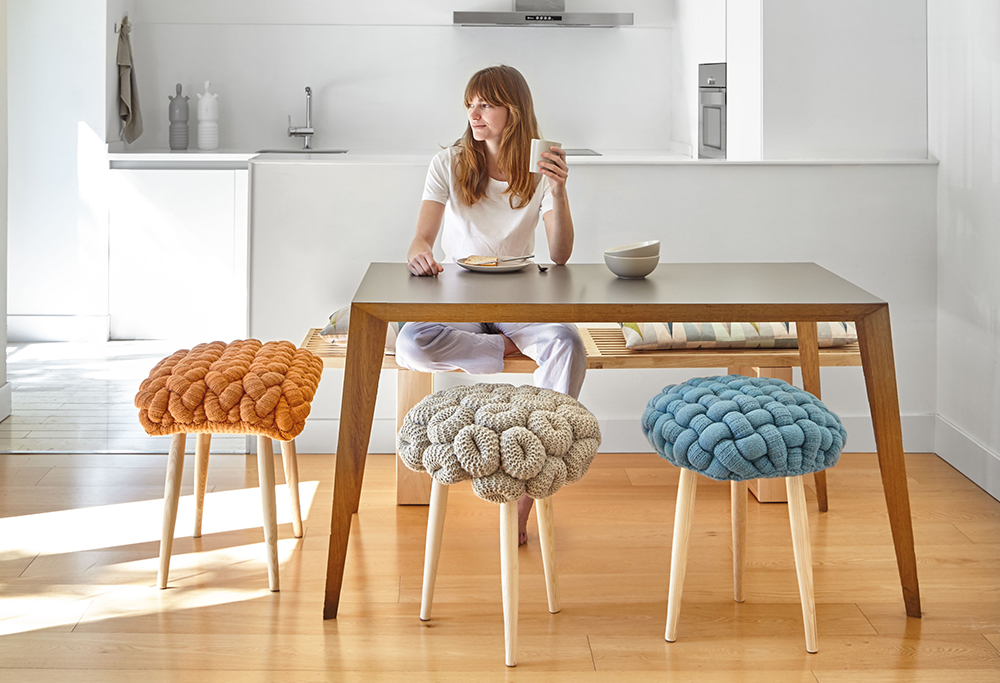
Avant-garde design advances driven by ancient traditions
This meticulous work, carried out by expert hands in India, has become the vehicle that drives the creativity of the prestigious designers who collaborate with GAN.
In this way, GAN’s manufacturing system not only supports the economic development of the areas where its products are made, but also preserves cultural traditions and makes them grow, revaluing them. Artisan practice evolves and, at the same time, establishes new milestones in contemporary design.
New uses and proportions combine contemporary design with traditional craftsmanship
Techniques that have existed forever, such as knitting, are now adapted to new uses and dimensions and make GAN unique, opening up unexplored paths where craftsmanship, avant-garde industrial design, and social and environmental commitment all come together.
The KNITTED STOOLS collection, created by Claire-Anne O’Brien, is a good example of a design that uses traditional techniques with a radically different perspective. Hand-knitted in brightly colored wool and made of interlocking smooth or ribbed tubes, KNITTED STOOLS stand out for their cozy seat and base made of ash wood, resistant and casual.

On the other hand, the charm of embroidery, needlepoint, cross-stitch, and chain-stitch comes to light in series such as SILAÏ, CANEVAS, and CHADDAR, by Charlotte Lancelot, LAN, by Neri&Hu, and BANDAS, by Patricia Urquiola. Many of the pieces that make up these collections are made by the artisans of the GAN Women’s Unit, who embroider in the same way that clothing and home textiles were traditionally embroidered: only material and scale vary, oversized to fit the size of rugs and poufs.
Discovering different effects, shapes, and textures through material research has also led GAN to create new techniques, such as the felt agglomerate that recycles discarded wool fibers to shape the NUANCES rugs and poufs, designed by Urquiola and sewn by hand. This reinvented and sustainable felt has a heterogeneous and natural texture. The technique used differs from traditional manufacturing parameters and focuses on the circular economy by giving a new life to discarded wool.

Ancient rituals that live on
These innovations find their place in GAN’s catalog alongside ancient methods of rug making.
Hand-knotting is one of the most classic techniques. This type of rug is woven by hand on a vertical loom where the wool is tightly bound to the warp with a knot. The greater the number of knots, the greater the definition, durability, and value of the rug. This can be observed at a glance at MIRAGE, by Patricia Urquiola, a technically complex rug to produce. Its color variations and incredibly detailed design require the time and skill of expert weavers who have mastered the laborious art of hand-knotting.

Other techniques with centuries of history and always present in the GAN catalog are kilim and dhurrie: hand-woven rugs, without tufts or knots, made of natural fibers. The ROOTS kilims, designed by Inma Bermúdez, are made by tightly weaving the weft on a loom, a technique similar to that used in the manufacture of tapestries. In jute and cotton, the ROOTS kilims celebrate the millenary craft of weavers.

The handloom technique allows for a wide range of designs and finishes, from flat carpets to pieces of thick knotted, cut, plaited, or looped yarns. MANGAS ORIGINAL, designed by Patricia Urquiola, exemplifies many of these options. Made on handlooms that combine different textures and types of stitches of virgin wool, the elements of the MANGAS ORIGINAL collection are inspired by the look of handmade sweaters to convey the same sense of warmth and volume. In some models, the yarn is attached to the warp by winding it around a rod that determines the pile height of the rug, in others, it is simply interwoven.
PLASTIC RIVERS, one of the most recent GAN collections, embodies the brand’s social commitment to craftsmanship and the environment. These rugs are made from 100% recycled PET fibers. They are produced by artisans using the hand-tufted method, so no industrial machinery is needed and no emissions are generated. On a stretched cotton canvas, a tufting gun shoots and cuts a portion of PET thread following the desired pattern – in the case of PLASTIC RIVERS, faithful cartographic representations of rivers such as the Ganges or the Indus rivers.

Recycled materials and the best natural fibers – such as wool, jute, and cotton – are the raw materials used by craftsmen and craftswomen who, thanks to their work and the involvement of GAN’s team, protect, recover and revisit techniques rooted in ancient cultures. The result is handmade rugs, true luxury pieces that gain in beauty and meaning over time. Their textures, shapes, and volumes reveal the secrets of the artisanal techniques that make up the essence and purpose of GAN.





